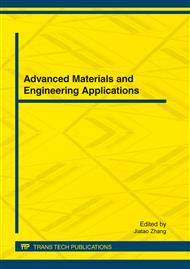[1]
M. A. Khan, R. L. Williams, D. F. Williams , The corrosion behavior of Ti–6Al–4V, Ti–6Al–7Nb and Ti–13Nb–13Zr in protein solutions, Biomaterials, 17(1999) 631-637.
DOI: 10.1016/s0142-9612(98)00217-8
Google Scholar
[2]
E. D. Spoerke, S. I. Stupp, Colonization of organoapatite-titanium mesh by preosteoblastic cells, Journal of Biomedical Materials Research Part A, 3(2003) 960-969.
DOI: 10.1002/jbm.a.10102
Google Scholar
[3]
A. Yuda , S. Ban, Y. Lzumi, Biocompatibility of apatite-coated titanium mesh prepared by hydrothermal-electrochemical method, Dental Materials Journal, 4(2005) 588-595.
DOI: 10.4012/dmj.24.588
Google Scholar
[4]
M. P. Martin, S. Olson, Post-operative complications with titanium mesh, Journal of Clinical Neuroscience, 8(2009) 79-82.
Google Scholar
[5]
Q. F. Yang, S. K. Qian, X. B. Chen, et al, Comparison of digitized titanium net cranioplasty with manually generated titanium net cranioplasty, Chin J Clin Neurosurg,10(2001) 600,608.
Google Scholar
[6]
M. Thomasson, H. Hedman, D. Guo, et al, Lrigl and epidermal growth factor receptor in renal cell carcinoma: a quantitative RT-PCR and immunohistochemical analysis, Bu J Cancer,7(2003) 1285-1289.
DOI: 10.1038/sj.bjc.6601208
Google Scholar
[7]
J. J. Chen, W. Liu, M. Z. LI, et cal, Digital manufacture of titanium prosthesis for cranioplasty, Int J Adv Manuf Technol, 27(2006) 1148-1152.
DOI: 10.1007/s00170-004-2309-y
Google Scholar
[8]
X. R. Liu, B. Zhang, J. Yu, The clinical applications of titanium mesh multi-point forming in craniocerebral trauma patients, Jouranl of Neurotrauma , 5(2008) A14-A14.
Google Scholar
[9]
M. Z. Li, Z. Y. Cai, Q. G. Yang , Multi-point forming technology for sheet metal, J. Mater. Process. Technol., 1-3(2002): 333-338.
Google Scholar
[10]
M. Z. Li, Z. Y. Cai, C. G. Liu, Flexible manufacturing of sheet metal parts based on digitized-die, Robot. CIM- Int. Manuf., 1(2007): 107-105.
Google Scholar
[11]
M. Z. Li, Z. Y. Cai, C. G. Liu, W. Z. Fu, Recent development in multi-point forming technology, Proceedings of the 8th International Conference on Technology of Plasticity, 2005. pp.707-708.
Google Scholar
[12]
F.X. Tan, M. Z. Li, Z. Y. Cai, Research on the process of multi-point forming for the customized titanium alloy cranial prosthesis. J. Mater. Process. Technol., 187(2007) 453-457.
DOI: 10.1016/j.jmatprotec.2006.11.149
Google Scholar
[13]
F.X. Tan, M. Z. Li, Z. Y. Cai, et cal, Formability analysis on the process of multi-point forming for titanium alloy retiary sheet, Int J Adv Manuf Technol, 41(2009) 1059-1065.
DOI: 10.1007/s00170-008-1548-8
Google Scholar


